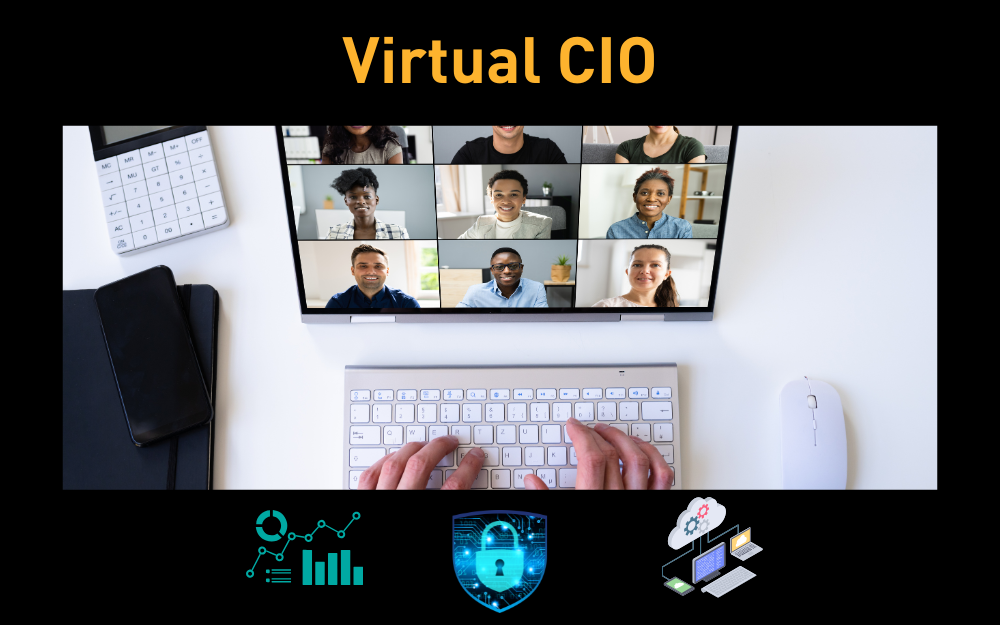
In today’s fast-paced digital world, businesses of all sizes need to make strategic technology decisions that align with their goals and objectives. For small businesses, however, the complexity and cost of hiring a full-time Chief Information Officer (CIO) can be prohibitive. This is where a Virtual CIO (vCIO) comes in—a cost-effective solution that provides businesses with the expertise and guidance they need to leverage technology for growth, security, and efficiency.
But what happens if you don’t have a vCIO? The absence of this role can lead to several risks that may hinder your business’s progress, leaving it vulnerable to inefficient technology strategies, budget overruns, and missed opportunities. In this blog, we’ll explore the advantages of having a vCIO for your small business and discuss the potential risks of going without one.
What is a Virtual CIO (vCIO)?
A Virtual Chief Information Officer (vCIO) is an outsourced IT leader who works with your business on a part-time or contract basis to provide strategic technology advice and solutions. A vCIO acts as a trusted advisor, helping your company make informed decisions about technology infrastructure, software tools, security, and long-term IT strategies.
For small businesses that may not have the resources to hire a full-time CIO, a vCIO can provide the expertise and strategic insight needed to align technology with business goals, drive innovation, and optimize performance.
Key Advantages of Having a vCIO
1. Strategic Technology Guidance
A vCIO is more than just a technician; they are a strategic partner who helps guide the overall technology direction of your business. By understanding your company’s goals, operations, and challenges, a vCIO can offer tailored recommendations that support growth and innovation. Whether it’s choosing the right software, improving business processes, or managing cybersecurity, a vCIO provides the expertise needed to ensure your technology infrastructure is aligned with your objectives.
Without a vCIO, businesses risk making reactive decisions about technology, such as purchasing the wrong systems or failing to integrate tools that could enhance efficiency. A vCIO helps you avoid these pitfalls by providing a comprehensive IT roadmap that supports your company’s long-term vision.
2. Budgeting and Cost Efficiency
Managing technology expenses can be tricky, especially when you don’t have a dedicated IT leader. A vCIO helps small businesses develop a realistic IT budget that aligns with their goals, priorities, and financial capabilities. By assessing your current technology stack and understanding your business needs, a vCIO can recommend cost-effective solutions, eliminate waste, and avoid unnecessary spending.
Without a vCIO, businesses may end up overspending on unnecessary hardware or software, or worse, under-investing in critical systems that could improve efficiency or protect against cyber threats. A vCIO ensures that your IT budget is optimized for maximum ROI.
3. Alignment of Technology with Business Goals
Technology should be an enabler of business growth, but all too often, businesses implement systems without considering how they align with their long-term goals. A vCIO works with your leadership team to ensure that your technology strategy is directly aligned with your business objectives. This includes evaluating your business processes, identifying inefficiencies, and recommending technologies that streamline operations, improve customer experience, and increase productivity.
Without a vCIO, businesses risk using outdated or misaligned technology that can hinder productivity, create bottlenecks, and frustrate employees. A vCIO ensures that your technology investments are a catalyst for success, not an obstacle.
4. Improved Risk Management and Cybersecurity
Cybersecurity is one of the biggest challenges facing businesses today, and small businesses are particularly vulnerable to cyber threats. A vCIO helps create and implement a robust cybersecurity plan tailored to your business, reducing the risk of data breaches, ransomware attacks, and other security threats.
Additionally, a vCIO provides risk management strategies that ensure your business is compliant with industry regulations, keeps your systems secure, and minimizes downtime caused by technological failures. Without this expertise, businesses may leave themselves exposed to costly cyberattacks and regulatory fines.
5. Scalability and Future-Proofing
As your business grows, your technology needs will evolve. A vCIO ensures that your IT infrastructure is scalable and can support future growth. Whether it’s upgrading systems, migrating to the cloud, or implementing automation tools, a vCIO helps future-proof your business by recommending scalable solutions that grow with you.
Without a vCIO, businesses may struggle to scale their technology, leading to bottlenecks, system failures, or delays in implementing new solutions. A vCIO keeps your technology ahead of the curve, ensuring you’re always prepared for the next phase of growth.
The Risks of Not Having a vCIO
Without a vCIO, small businesses face several risks, including:
- Inefficient Technology Decisions: Without strategic advice, businesses may implement technology that doesn’t align with their goals, leading to inefficiencies, wasted resources, and missed opportunities.
- Increased Costs: Without expert guidance, businesses may overspend on technology that’s not cost-effective or under-invest in critical infrastructure, leading to expensive repairs or replacements down the line.
- Security Vulnerabilities: Small businesses without a vCIO are more likely to fall victim to cyberattacks, data breaches, and compliance issues due to a lack of cybersecurity planning and risk management.
- Missed Opportunities for Innovation: Technology evolves quickly, and businesses that don’t have a vCIO may miss out on the latest tools and innovations that could give them a competitive edge.
- Lack of Alignment with Business Goals: Without a vCIO, technology investments may not be aligned with the business’s strategic objectives, which can lead to wasted time, effort, and money.
Conclusion
The absence of a vCIO can expose your small business to unnecessary risks and challenges. By working with a Virtual CIO, you gain access to expert guidance, strategic planning, and tailored technology solutions that can drive your business forward. From budgeting and aligning technology with business goals to managing cybersecurity risks and scaling for future growth, a vCIO offers the expertise and support that every small business needs to thrive in today’s digital landscape.
Investing in a vCIO is an investment in the future of your business—ensuring you have the technology infrastructure, security, and strategy in place to stay competitive, innovative, and secure.
To get started, call our office at 909-654-6444 or click here to schedule a consultation.
